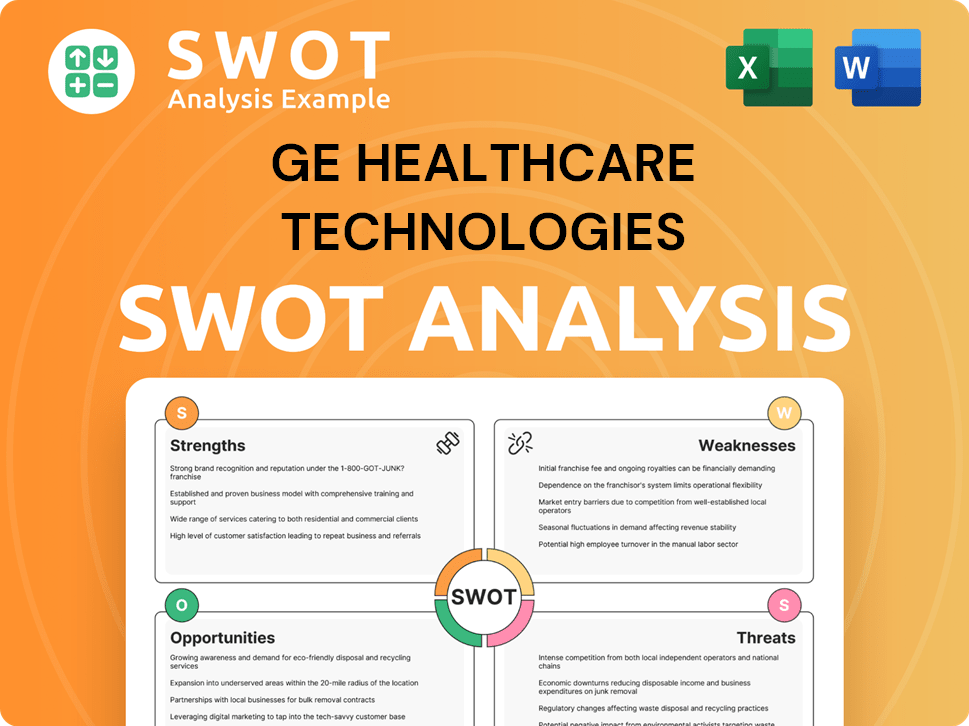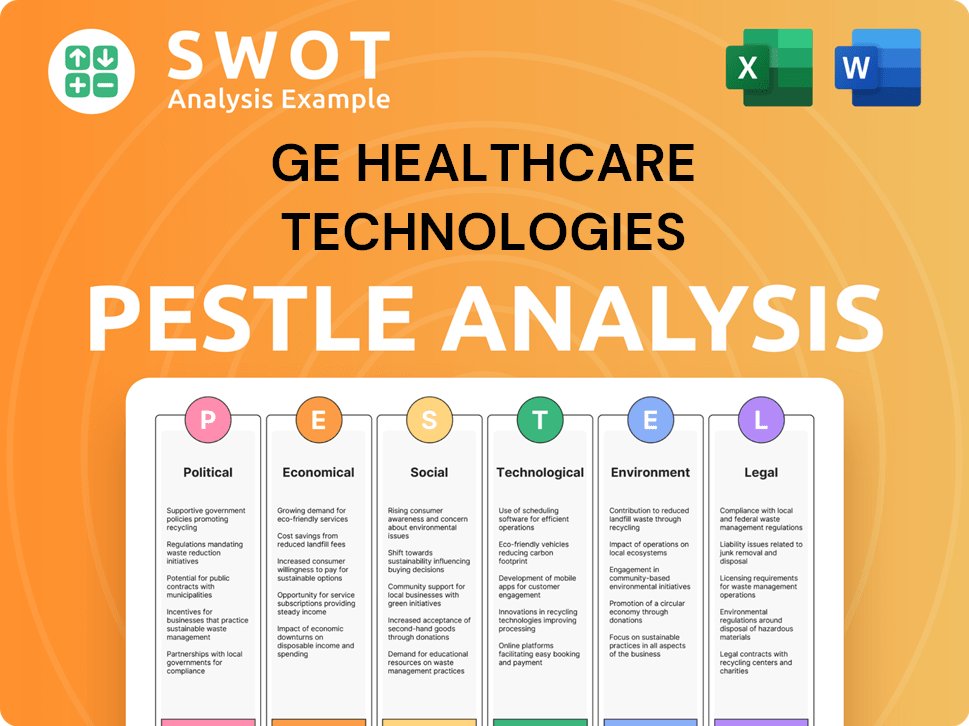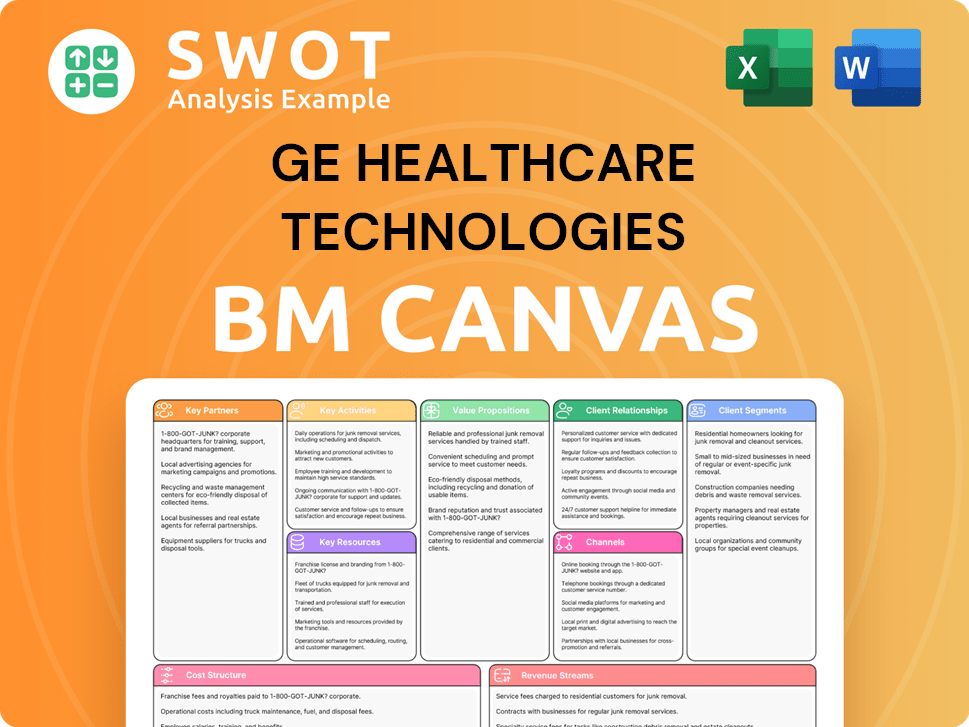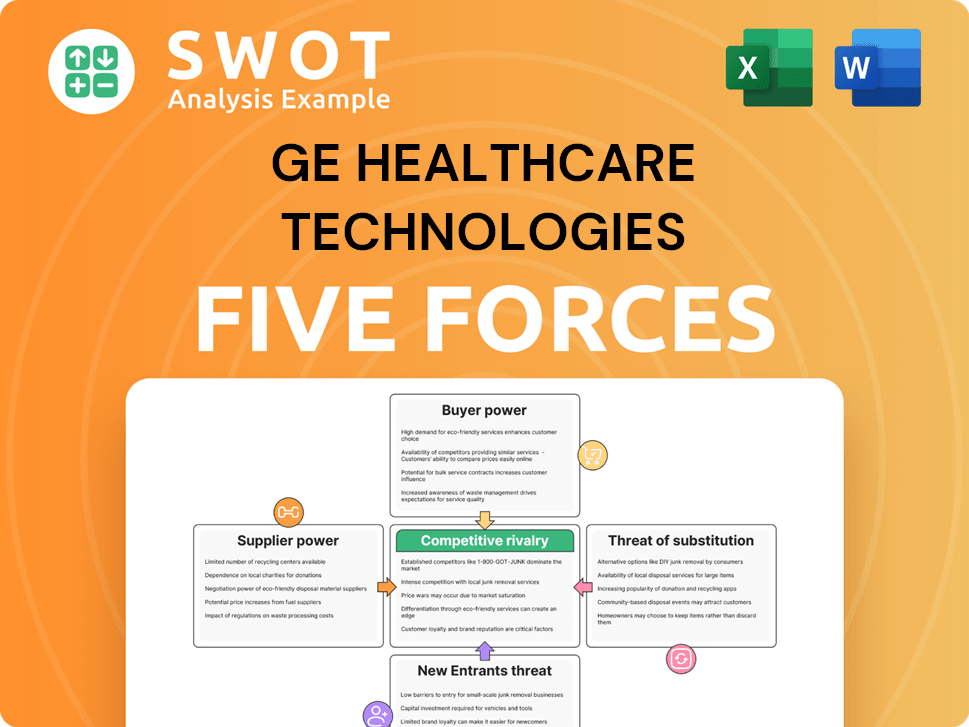GE HealthCare Technologies Bundle
How did GE HealthCare revolutionize the healthcare industry?
GE HealthCare Technologies, a titan in medical technology, pharmaceutical diagnostics, and digital solutions, boasts a rich history of innovation aimed at transforming patient care. Its story began with a commitment to leveraging technology for better health outcomes, evolving from its roots within General Electric to become a standalone entity in January 2023. This evolution showcases a century-long dedication to pioneering advancements in the GE HealthCare Technologies SWOT Analysis.

Tracing the brief history of GE HealthCare Technologies reveals a journey marked by significant milestones in medical technology, including groundbreaking developments in medical imaging and patient monitoring. From its origins within General Electric, GE HealthCare has consistently pushed boundaries, contributing significantly to the healthcare industry's advancements. Understanding GE HealthCare's evolution provides crucial insights into its current market position and future strategic plans, making it a key player to watch in healthcare innovation.
What is the GE HealthCare Technologies Founding Story?
The story of GE HealthCare Technologies begins long before its formal establishment as an independent entity in January 2023. Its roots are firmly planted in the history of General Electric, specifically with the acquisition of the Victor Electric Company in 1920. This acquisition marked the beginning of GE's venture into the healthcare sector, laying the groundwork for what would become a global leader in medical technology.
Victor Electric, a pioneer in X-ray technology, became the cornerstone of GE's healthcare division. The early innovators identified the critical need for non-invasive diagnostic tools to visualize the human body. X-ray technology provided a groundbreaking solution to this challenge at the time, revolutionizing medical diagnostics.
The initial business model focused on manufacturing and distributing X-ray machines and related equipment to hospitals and medical practitioners. Funding for this early venture was integrated within General Electric's broader corporate investments. The early 20th century, characterized by rapid industrialization and scientific advancements, provided a conducive environment for the development and adoption of such groundbreaking medical technologies. The expertise within Victor Electric, combined with GE's manufacturing capabilities and research infrastructure, fueled the initial growth of this nascent healthcare venture. Learn more about the Owners & Shareholders of GE HealthCare Technologies.
GE HealthCare's journey began with the acquisition of Victor Electric Company in 1920.
- Victor Electric was a pioneer in X-ray technology.
- The initial focus was on manufacturing and distributing X-ray machines.
- Early funding was integrated within General Electric's broader investments.
- The company benefited from the rapid industrialization and scientific advancements of the early 20th century.
GE HealthCare Technologies SWOT Analysis
- Complete SWOT Breakdown
- Fully Customizable
- Editable in Excel & Word
- Professional Formatting
- Investor-Ready Format

What Drove the Early Growth of GE HealthCare Technologies?
The early growth and expansion of the healthcare division within General Electric, which later became GE HealthCare, was marked by significant advancements in medical imaging. This period saw the introduction of cutting-edge X-ray machines and a strategic move into new imaging technologies. These innovations, along with strategic acquisitions and partnerships, played a crucial role in establishing GE HealthCare Technologies as a major player in the healthcare industry.
Following the integration of Victor Electric, GE HealthCare steadily improved its X-ray technology. This was a pivotal period for GE HealthCare history. The company expanded into modalities like computed tomography (CT) in the 1970s and magnetic resonance imaging (MRI) in the 1980s. These early product launches were crucial in establishing GE HealthCare as a leader in diagnostic imaging, contributing significantly to the evolution of the healthcare industry.
GE's existing global infrastructure facilitated entry into new geographical markets. This allowed GE HealthCare to bring advanced medical technology to a broader patient base. This expansion was supported by GE's established international presence, allowing for effective distribution and service networks. This global reach was a key factor in its early success.
The acquisition of Marquette Medical Systems in 1998 significantly enhanced GE's presence in patient monitoring and cardiology solutions. These strategic moves were essential for expanding its product portfolio. This period also saw increased investment in research and development. The company's focus was on integrating complex technologies to provide comprehensive diagnostic and monitoring solutions.
The market largely responded positively to GE HealthCare's innovations, driven by clear clinical benefits. The company faced competition from other emerging medical technology companies. Despite the competitive environment, GE HealthCare solidified its position as a diversified healthcare technology provider. To learn more about the company's financial aspects, consider reading about the Revenue Streams & Business Model of GE HealthCare Technologies.
GE HealthCare Technologies PESTLE Analysis
- Covers All 6 PESTLE Categories
- No Research Needed – Save Hours of Work
- Built by Experts, Trusted by Consultants
- Instant Download, Ready to Use
- 100% Editable, Fully Customizable

What are the key Milestones in GE HealthCare Technologies history?
The brief history of GE HealthCare Technologies is marked by significant milestones in the medical technology sector. From its origins within General Electric to its recent spin-off, the company has consistently pushed boundaries in healthcare innovation.
| Year | Milestone |
|---|---|
| 1980s | GE developed the first commercial MRI scanner, revolutionizing diagnostic medicine. |
| 2010s | Introduction of the Revolution CT scanner, significantly reducing scan times and improving image quality. |
| January 2023 | Spin-off from General Electric, valued at approximately $31.5 billion, allowing focus on healthcare. |
GE HealthCare has been at the forefront of medical technology, consistently introducing groundbreaking innovations. These advancements have improved patient care and diagnostic capabilities across the healthcare industry.
Pioneering advancements in MRI technology, enhancing image quality and diagnostic accuracy. This includes innovations in scanner design and imaging algorithms.
Development of advanced CT scanners that reduce scan times and improve image resolution. These advancements have led to better patient outcomes and faster diagnoses.
Innovations in ultrasound technology, providing real-time imaging for various medical applications. These include improved resolution and portability.
Advancements in molecular imaging techniques, enabling the detection of diseases at the cellular level. This includes PET and SPECT imaging technologies.
Development of digital health platforms to improve workflow efficiency and patient outcomes. These platforms integrate data and analytics for better decision-making.
Expansion into biomanufacturing solutions to support the production of pharmaceuticals and biologics. This includes advanced technologies for cell culture and purification.
Despite its successes, GE HealthCare has faced challenges, including market fluctuations and regulatory complexities. The healthcare industry's competitive landscape and the need for continuous innovation have also presented obstacles.
Economic downturns, such as the 2008 financial crisis, impacted capital expenditures in healthcare, affecting equipment sales. This required strategic adjustments to maintain market share.
Competition from other major medical technology companies necessitated continuous innovation and strategic repositioning. This involved investments in research and development.
Product failures or recalls, although rare, presented challenges, requiring robust quality control and responsive communication. This impacted customer trust and brand reputation.
Increasing complexity of healthcare regulations and the demand for value-based care models pushed GE HealthCare to adapt its business strategies. This included focusing on integrated solutions and digital health platforms.
The spin-off from General Electric presented challenges related to establishing an independent operational structure. This required significant restructuring and strategic planning.
Rapid advancements in precision care, digital transformation, and biomanufacturing require agility and responsiveness to market dynamics. This necessitates continuous adaptation and innovation.
For a deeper dive into the competitive environment, consider exploring the Competitors Landscape of GE HealthCare Technologies.
GE HealthCare Technologies Business Model Canvas
- Complete 9-Block Business Model Canvas
- Effortlessly Communicate Your Business Strategy
- Investor-Ready BMC Format
- 100% Editable and Customizable
- Clear and Structured Layout

What is the Timeline of Key Events for GE HealthCare Technologies?
The story of GE HealthCare Technologies is a journey of innovation and growth in the healthcare industry. From its early beginnings with the acquisition of Victor Electric Company in 1920, which marked its entry into X-ray technology, to its recent spin-off from General Electric in January 2023, the company has consistently pushed the boundaries of medical technology. Key milestones include the introduction of groundbreaking technologies like CT and MRI scanners in the 1970s and 1980s, the acquisition of Marquette Medical Systems in 1998, and the launch of the Revolution CT scanner in 2011. GE HealthCare's role expanded during the COVID-19 pandemic, providing essential medical equipment. The company's commitment to innovation continues with a focus on precision care and digital transformation.
| Year | Key Event |
|---|---|
| 1920 | General Electric acquired Victor Electric Company, entering the healthcare sector with X-ray technology. |
| 1970s | Introduced the first Computed Tomography (CT) scanners, revolutionizing diagnostic imaging. |
| 1980s | Pioneered Magnetic Resonance Imaging (MRI) technology, expanding diagnostic capabilities. |
| 1998 | Acquisition of Marquette Medical Systems expanded presence in patient monitoring and cardiology. |
| 2011 | Introduced the Revolution CT scanner, setting new benchmarks in imaging. |
| 2020 | Played a critical role in the global response to the COVID-19 pandemic, providing medical equipment. |
| January 2023 | GE HealthCare Technologies officially spun off from General Electric, becoming an independent company. |
| 2024 | Reported Q1 revenue of $4.6 billion, reflecting 8% organic growth. |
GE HealthCare is investing heavily in precision care, aiming to provide more tailored treatments. This involves leveraging advanced imaging and data analytics. The goal is to improve patient outcomes through personalized healthcare strategies. The company is also focused on developing advanced therapy solutions.
The company is driving digital transformation across its operations. This includes integrating artificial intelligence (AI) into diagnostic tools. AI is being used to enhance image analysis and improve workflow efficiency. This strategy helps to improve the speed and accuracy of diagnoses.
GE HealthCare is expanding its presence in biomanufacturing and advanced therapies. This involves developing new technologies for drug development and production. The company aims to support the growth of innovative treatments. This expansion aligns with industry trends.
In Q1 2024, GE HealthCare reported strong financial results, with revenue growth. The company anticipates continued organic revenue growth of between 4% to 5% for 2024. The adjusted EPS is projected to be between $4.20 and $4.35, indicating strong financial health.
GE HealthCare Technologies Porter's Five Forces Analysis
- Covers All 5 Competitive Forces in Detail
- Structured for Consultants, Students, and Founders
- 100% Editable in Microsoft Word & Excel
- Instant Digital Download – Use Immediately
- Compatible with Mac & PC – Fully Unlocked

Related Blogs
- What is Competitive Landscape of GE HealthCare Technologies Company?
- What is Growth Strategy and Future Prospects of GE HealthCare Technologies Company?
- How Does GE HealthCare Technologies Company Work?
- What is Sales and Marketing Strategy of GE HealthCare Technologies Company?
- What is Brief History of GE HealthCare Technologies Company?
- Who Owns GE HealthCare Technologies Company?
- What is Customer Demographics and Target Market of GE HealthCare Technologies Company?
Disclaimer
All information, articles, and product details provided on this website are for general informational and educational purposes only. We do not claim any ownership over, nor do we intend to infringe upon, any trademarks, copyrights, logos, brand names, or other intellectual property mentioned or depicted on this site. Such intellectual property remains the property of its respective owners, and any references here are made solely for identification or informational purposes, without implying any affiliation, endorsement, or partnership.
We make no representations or warranties, express or implied, regarding the accuracy, completeness, or suitability of any content or products presented. Nothing on this website should be construed as legal, tax, investment, financial, medical, or other professional advice. In addition, no part of this site—including articles or product references—constitutes a solicitation, recommendation, endorsement, advertisement, or offer to buy or sell any securities, franchises, or other financial instruments, particularly in jurisdictions where such activity would be unlawful.
All content is of a general nature and may not address the specific circumstances of any individual or entity. It is not a substitute for professional advice or services. Any actions you take based on the information provided here are strictly at your own risk. You accept full responsibility for any decisions or outcomes arising from your use of this website and agree to release us from any liability in connection with your use of, or reliance upon, the content or products found herein.